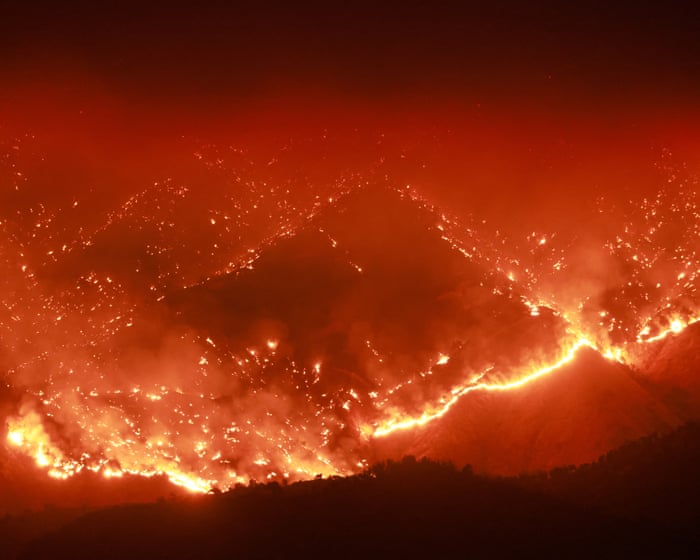Experts and new research indicate that the climate crisis will lead to more frequent lightning-sparked wildfires in the coming decades, with cascading effects that threaten public safety and health. Lightning-caused fires often burn in remote areas, allowing them to grow larger than human-caused fires. This trend toward more lightning-ignited blazes is likely making wildfires deadlier by increasing smoke and worsening air quality across the country, especially in recent years.
Over the past 40 years, thunderstorms and conditions favorable to lightning have become more common in many parts of the western U.S., including western Washington, western Oregon, California’s Central Valley, and higher elevations in the Rocky Mountains. This pattern isn’t limited to the U.S.—this year’s record-breaking fire season in Europe, partly driven by lightning fires in Spain, and massive blazes in Canada, where lightning caused most of the fires that burned over twice the normal forest area, highlight the global scale of the issue.
Although the trend toward worsening fires is well-documented, most climate models have been too broad to capture how the relationship between lightning and wildfires will evolve as the climate crisis intensifies. A recent study used machine learning to address this gap, analyzing future changes in lightning frequency alongside weather variables like temperature, humidity, wind, and soil moisture that influence fire spread.
Dmitri Kalashnikov, the study’s lead author and a climate scientist at UC Merced’s Sierra Nevada Research Institute, stated, “The overall signal is that we will have more risk of lightning-caused fires.” His findings are especially relevant as this year’s U.S. wildfire season escalates in a way that mirrors his predictions—dry thunderstorms in California this week triggered thousands of lightning strikes, sparking at least 20 new fires that burned tens of thousands of acres and destroyed structures in areas like Chinese Camp.
The study revealed regional variations: the inland Pacific Northwest may see more lightning but only a slight rise in fire risk due to increased moisture, while the desert Southwest could face higher fire danger with little change in lightning days because of worsening drought. Despite these differences, the conclusion was clear: nearly everyone will experience greater wildfire risk in the future. In fact, Kalashnikov’s team projected increases in lightning-caused fires across 98% of the western U.S., driven by more lightning, more fire-friendly weather, or both.
With firefighting resources already stretched, the rise in remote lightning fires is concerning. Wildfire smoke has been responsible for about 1,000 U.S. deaths annually over a recent 15-year period. A surge in lightning-caused fires could push that number to over 20,000 per year by mid-century.
Beyond fire risk, the study noted that more thunderstorms and lightning in some western regions could also lead to increased flash flooding and mudslides, especially in burned areas. Additional smoke from these fires may deposit dark particles on glaciers in Canada, Greenland, and Europe, accelerating melting. The remote nature of lightning fires also strains emergency response capabilities.Even today, a sudden lightning storm can severely strain firefighting resources for weeks during peak wildfire season, according to Max Moritz, a wildfire specialist with the University of California Cooperative Extension and adjunct professor at UC Santa Barbara.
“A week or two later, you might get a major Santa Ana wind event,” Moritz added. “That combination creates a perfect recipe for disaster.”
As more people move into wildfire-prone areas across the western U.S., worsening fires could put further pressure on the insurance industry, which is already processing billions of dollars in claims from this year’s fires in Los Angeles alone.
Nationwide, firefighting resources are stretched thin due to budget cuts under the Trump administration to agencies like the National Oceanic and Atmospheric Administration, the National Park Service, and other federal organizations with staff across the West. By late July, more than a quarter of firefighting positions at the U.S. Forest Service were still unfilled. A recent immigration raid on an active firefighting crew in Oregon has also reportedly hurt morale.
Moritz suggests a partial solution: changing how we build cities in fire-prone regions.
Beyond implementing basic fire-safe building codes, he proposes creating agricultural buffers around urban areas to help shield homes and residents from advancing flames.
“There’s growing recognition that live fuel moisture—the water content in green leaves and twigs—plays a key role in fire behavior,” Moritz explained. “Here in Santa Barbara, we have an existing, though narrow, agricultural belt. In areas where it remains, wildfires can’t easily spread from the national forest into neighborhoods.”
Frequently Asked Questions
Of course Here is a list of FAQs about the study linking the climate crisis to more lightningsparked wildfires with clear and concise answers
General Beginner Questions
Q What is the main finding of this study
A The study found that as the planet gets warmer due to climate change there will be more lightning strikes which will lead to a significant increase in the number of wildfires started by lightning
Q Why does a warmer climate create more lightning
A Warmer temperatures cause more evaporation putting more moisture into the atmosphere This leads to stronger more frequent thunderstorms which are the primary source of lightning
Q Arent most wildfires started by people
A While human activity is a major cause of wildfires lightning is a leading natural cause This study shows that the natural lightningcaused portion is expected to grow
Q Why are lightningcaused wildfires a bigger problem
A They often start in remote rugged areas that are difficult for firefighters to reach quickly They can grow very large before they are even detected making them harder to control
Advanced Detailed Questions
Q How much of an increase in lightning wildfires are we talking about
A While the exact number varies by region and model studies generally project an increase of 10 to 50 in lightningcaused wildfires for every 1C of global warming
Q Which regions will be most affected by this change
A Regions with boreal forests like Northern Canada Alaska and Siberia are particularly vulnerable However temperate forests and other fireprone ecosystems around the world will also see an increase
Q Does this mean there will be less rain to counteract these fires
A Not necessarily The climate crisis can create dry lightning eventsthunderstorms that produce lightning but little to no rain This is a worstcase scenario as it provides the ignition source without the moisture to suppress a fire
Q What data or models did this study use to make these predictions
A Scientists typically use complex climate models that simulate future temperature humidity and atmospheric instability They combine this with historical data on lightning strikes and wildfire ignitions to project future trends
Practical Impact Questions




